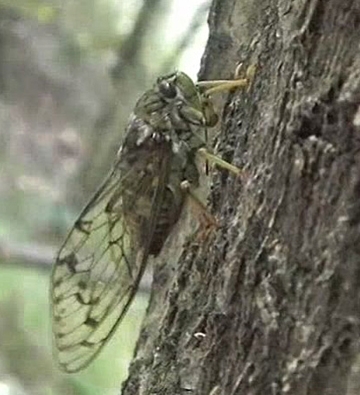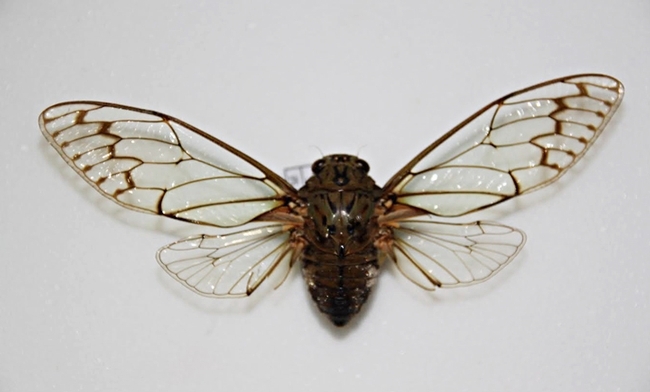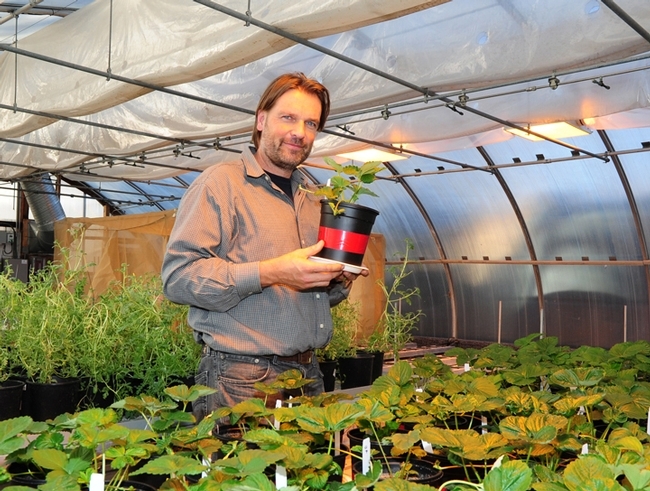
All the more reason to appreciate what Christian Nansen, agricultural entomologist at the University of California, Davis, and two of his colleagues just did.
Nansen and Changquing Luo and Cong Wei, both from China's Northwest A&F University, just published their research on the so-called "mute" cicadas. Are they really mute? If so, how do they communicate and attract mates?
Their work, “How Do ‘Mute' Cicadas Produce their Calling Songs?”, appears in the Feb. 25th edition of PLOS ONE, an open access peer-reviewed scientific journal published by the Public Library of Science.
Cicadas in the genus Karenia lack the specialized sound-producing structures that characterize most cicadas, says Nansen, an assistant professor in the UC Davis Department of Entomology and Nematology. They have no tymbal mechanism.
But they are not mute. “They do indeed produce sounds,” he says.
In ground-breaking research, the scientists discovered a new sound-production mechanism in Karenia caelatata, which produces impact sounds by banging the forewing costa against the operculum. It's somewhat like beating a drum while other cicada species with tymbal mechanisms play an orchestra of diverse and loud sounds.
“As part of quantifying species' differences in behavior, we used hyperspectral imaging of forewing costae and demonstrated that high-spectral resolution imaging can reveal distinct patterns, such as difference between mute and normal cicadas,” Nansen explained. “So application of such imaging technologies may become a ‘bridge' between in-depth field behavioral research and detailed physiology and histology (structural studies) of insect body parts.”
In their publication, the researchers described the temporal, frequency and amplitude of the sound produced. They also posted the sound on YouTube,
“Morphological studies and reflectance-based analyses reveal that the structures involved in sound production of K. caelatata (i.e., forewing, operculum, cruciform elevation, and wing-holding groove on scutellum) are all morphologically modified,” they wrote. “Acoustic playback experiments and behavioral observations suggest that the impact sounds of K. caelatataare used in intraspecific communication and function as calling songs.”
“The new sound-production mechanism expands our knowledge on the diversity of acoustic signaling behavior in cicadas and further underscores the need for more bioacoustic studies on cicadas which lack tymbal mechanism,” they concluded in their abstract.
Cicadas, also known as “tree crickets” (from Latin cicada), are among the most widely recognized of insects due to their large size (usually 2 to 5 centimeters or more) and loud sound. They live in warm climates, from temperate to tropical. Immature cicadas spend most of their lives sucking juice from tree roots. The adults suck plant juices from stems.
The best-known North American genus, Magicicada, has a long life cycle of 13 or 17 years and emerges in great numbers.
Nansen joined the UC Davis Department of Entomology and Nematology in January. He is focusing on four major themes: host plant stress detection, host selection by arthropods, pesticide performance, and use of reflectance-based imaging in a wide range of research applications.
Already he is using his international expertise to zero in on more sustainable farming systems, better food production and fewer pesticides.
“The agricultural sector in California is so exciting, because of its diversity and economic importance,” said Nansen, whose agricultural entomology expertise encompasses seven countries including his native Denmark. “Secondly, there is a strong spirit of innovation in this region, and I hope to contribute to the development of highly advanced crop monitoring systems and decision support tools, so that farming practices can become less reliant on pesticides.”
“I also believe that the strong academic programs at UC Davis with ecology and evolution are of incredible value, and that we can integrate the basic theory from these disciplines into the fundamental of crop management to obtain more sustainable farming systems,” Nansen said. “As an example of a line of research I am interested in – application of fertilizers obviously affect crop growth, but they also affect the attractiveness of crops to many insect pests, and they influence the ability of plants to resist attacks by several important insect pests.”
“So, how can we optimize use of crop fertilizers to stimulate yields but also minimize risks of pest infestations? The answer to such a question is underpinned by in-depth understanding about host selection ecology and about fitness and evolutionary processes involved in host adaptation. In other words, it is critically important to demonstrate how we can use studies of agricultural systems to learn about the ecology of species and their food webs and evolutionary processes.”
Born and educated in Denmark, Nansen received his master's degree in biology from the University of Copenhagen in 1995 and his doctorate in zoology from the Royal Veterinary and Agricultural University in Denmark in 2000. He accepted positions in Portugal, Benin, United States, UK and Australia before coming to UC Davis. His international experience also includes being an international exchange student at the University of Lisbon, Portugal and a visiting professor at Northwest A&F University, Yangling, China.
As part of his undergraduate studies, Nansen took time off to travel to Brazil to write a book about sustainable agriculture in rainforest areas. “In this process, I learned about the potential of honey bees as both pollinators of crops but also as ‘promoters' more broadly of sustainable agricultural development,” Nansen said.
Nansen wrote his master's thesis on honey bees: “The Apis mellifera Forging Response to the Pollen Availability in Cistus salvifolius.” The plant isalso known as a sage-leaved rock rose or Gallipoli rose. He conducted field work in Portugal involving pollen identification, observations on daily flight and foraging activity, and modeling of pollen availability.
For his doctorate, his interest turned to the larger grain borer, a serious pest of stored maize and dried cassava roots. He wrote his dissertation on “The Spatial Distribution and Potential Hosts of the Larger Grain Borer, Prostephanus truncatus (Horn) (Coleoptera: Bostrichidae), in a forest in Benin, West Africa.” His research involved stored product insect ecology, field trapping with pheromone traps, experimental work on pheromone production, vegetation analysis, satellite image interpretation, laboratory infestation of potential breeding substrates, and histological studies.
“Agricultural entomology has given me so many opportunities to travel and work internationally, and that has been extremely rewarding,” he said. “I am passionate about food production and how to produce food ‘smartly' – so that it is profitable and also environmentally sustainable. And insects are critically important in manipulated food webs, such as, a crop field, forest, orchard, or horticultural greenhouse. I enjoy studying their ecological roles in these systems and how we can use that information to develop smarter ways to produce food.”
Read more about Nansen and his work on the UC Davis Department of Entomology and Nematology website and on his faculty website.
Attached Images:

